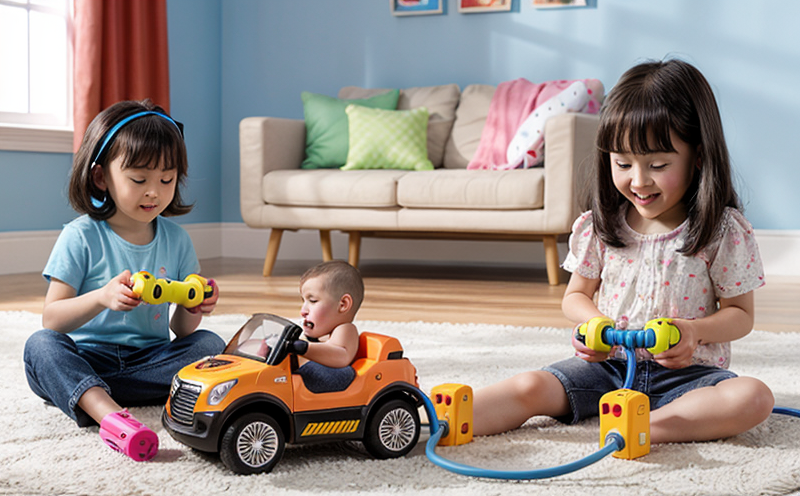ASTM F963 Electrical Overload and Safety Evaluation
The ASTM F963-17 Standard Consumer Safety Specification for Toy Safety sets forth important guidelines to ensure toys are safe for children. Among the many tests specified, electrical overload and safety evaluation is a critical step in ensuring that electrical and battery-operated toys do not pose risks of electrocution or fire.
The ASTM F963 Standard defines what constitutes an acceptable toy, covering numerous aspects including mechanical stability, flammability, choking hazards, and more. Electrical overload testing specifically examines whether the toy can withstand sudden power surges without causing a malfunction that could lead to injury. This test is essential for ensuring compliance with safety regulations.
The electrical overload test involves subjecting the toy’s electrical components to an overcurrent condition. The apparatus used for this includes a regulated current source capable of delivering up to 15 amperes, depending on the voltage rating of the circuit being tested. The toy is connected in series with the current source and a protective device such as a fuse or circuit breaker.
The test procedure typically involves applying a specified overcurrent condition for a defined duration, usually several minutes, to simulate real-world conditions where electrical components may experience temporary power surges. During this period, the tester monitors the toy’s response, including any changes in performance or signs of distress such as smoke emission.
Upon completion of the test, the toy is inspected for any visible damage, malfunctions, or other indicators that could compromise its safety. The acceptance criteria stipulate that a safe toy should not exhibit any hazardous conditions under these stressors. If the toy passes this test, it can be deemed compliant with ASTM F963’s electrical safety requirements.
Failure to pass this test indicates potential risks associated with the toy's design or manufacturing process. Manufacturers who wish to avoid recalls and protect their brand reputation should ensure that all toys undergo thorough testing according to these standards.
The importance of ASTM F963 compliance extends beyond mere regulatory requirements; it also enhances consumer trust in the quality and safety of products. By adhering to these stringent tests, companies demonstrate a commitment to protecting public health and welfare.
Why It Matters
The electrical overload test is pivotal for ensuring that toys comply with strict international standards aimed at safeguarding children’s wellbeing. Compliance with ASTM F963 not only meets legal requirements but also fosters trust among parents and guardians who rely on these tests to assess product safety.
- Legal Compliance: Ensures adherence to regulations set forth by the Consumer Product Safety Commission (CPSC) in the United States, which mandates compliance with ASTM F963 for toys sold within its jurisdiction.
- Risk Mitigation: Identifies potential hazards early on, reducing the likelihood of accidents involving children who might be exposed to unsafe electrical components.
- Brand Protection: Positive outcomes from rigorous testing help maintain a company’s reputation and credibility in the marketplace.
By incorporating ASTM F963 into their quality assurance processes, toy manufacturers can effectively minimize risks associated with electrical hazards. This proactive approach contributes significantly to enhancing overall product safety while aligning with global standards recognized by regulatory bodies worldwide.
Industry Applications
The ASTM F963 Standard is widely applicable across various sectors within the toy industry, particularly for manufacturers of electrical and battery-operated toys. These products often incorporate intricate electronic circuits, making them susceptible to electrical failures if not properly designed or manufactured.
Manufacturers must ensure their toys are safe under all reasonable conditions encountered during normal use as well as in situations where unexpected stresses might arise. The ASTM F963 test serves this purpose by simulating such stressors through controlled laboratory environments, thereby providing valuable insights into a toy's durability and reliability.
For instance, when designing an electric train set or a battery-powered remote-controlled vehicle, engineers must consider the impact of overcurrent conditions on both the toy itself and its associated power supply. By conducting ASTM F963-compliant tests early in the design phase, they can identify potential weak points before mass production begins.
This ensures that any necessary adjustments are made promptly, avoiding costly rework later down the line. Additionally, companies benefit from having data supporting their claims about product safety, which is crucial when marketing to consumers concerned with the well-being of their children.
Competitive Advantage and Market Impact
- Enhanced Safety Reputation: Passing ASTM F963 tests can significantly enhance a toy brand's reputation for safety, making it more attractive to consumers.
- Increased Consumer Confidence: Compliance with these rigorous standards builds trust among parents and guardians who value their children’s safety above all else.
- Higher Sales Potential: Products that meet or exceed regulatory requirements often command premium pricing, giving compliant brands a competitive edge in the marketplace.
- Regulatory Compliance: Ensures adherence to stringent safety guidelines set by governing bodies like the CPSC, avoiding costly fines and legal troubles.
In today’s highly competitive market, demonstrating a commitment to safety through rigorous testing processes like those outlined in ASTM F963 can be a decisive factor in standing out from competitors. Companies that prioritize these standards not only safeguard their products but also position themselves as leaders in child product safety.





